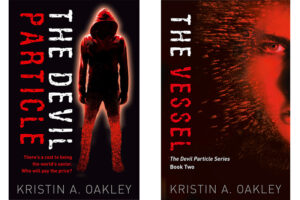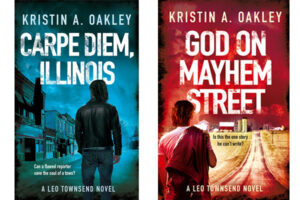Please note: This article was originally published on the Chicago Writers Association’s blog.
In 2012 when I was finishing my first novel Carpe Diem, Illinois, I’d heard about self-publishing but thought it was for authors who couldn’t get their books traditionally published. I reasoned that their writing just wasn’t good enough.
Two years later, self-publishing was losing some of its stigma. I knew my book was good, even if the thirty agents I pitched it to didn’t. I was impatient and wanted it out in the world, so I published the book and its sequel, God on Mayhem Street, through Little Creek Press. Both books won many awards, but they’re hard to market because they’re not genre-specific.
I’ve pitched other projects to agents but could never secure representation. For my newest series, I’ve decided to fully embrace self-publishing and not hire a publisher.
Here’s why:
First, some publishing facts:
- Traditional publishing (the big five publishing houses and their imprints)
- They can only be approached through a literary agent. There are several ways to acquire an agent:
- Pitching at conferences like CWA’s Let’s Just Write! An Uncommon Conference
- Pitching online during events like Twitter’s Pitch Wars – #PitMad
- Sending query letters to agents.
- Once you’ve acquired an agent, they sell your manuscript to a publisher.
- The publisher uses its own editors, cover and interior designers , and distributors.
- You have little or no say about the cover art or formatting.
- The publisher retains all creative rights.
- You may receive an advance ($5,000 – $10,000 for new authors is standard), but you receive no profits from the proceeds until the proceeds cover the advance.
- Typically, your agent gets 15% of the advance and the proceeds.
- If the proceeds cover the advance, you start to receive royalties. Generally, this is 10% of the proceeds (for self-publishing on Amazon, it can be as high as 70%).
- Some marketing may be provided, including the possibility of hiring a publicist, but this is usually reserved for big-name authors. First-time and mid-level authors generally do their own marketing.
- They can only be approached through a literary agent. There are several ways to acquire an agent:
- Small press publishing
- Generally, you can pitch to a small press without needing an agent.
- The press uses its own editors, cover and interior designers, and distributors.
- You may or may not have a say over the cover art.
- Depending upon the contract, the publisher might retain all creative rights.
- Contracts vary significantly, with some presses giving advances. Royalty percentages also vary.
- Some may help with the marketing, others don’t.
- Hybrid publishing (which is what I did with Little Creek Press)*
- You hire a publisher to publish the book or help with one or all aspects of the publishing process. According to The Reedsy blog, “It costs authors between $500 and $4,800 to publish a book. The cost of publishing depends on the services (editing, cover design, formatting, and marketing) you require, the genre and number of words of your manuscript, and your budget. From Reedsy’s 2023 data, prices range up to $2,000 for an editor and $750 for a book cover designer. “
- You retain all creative rights.
- You keep 100% of the proceeds after paying the publisher.
- Often, the author has to purchase a minimum number of books.
- You do all or most of the marketing.
- Indie publishing
- You handle all the publishing and everything that’s involved, including costs. See Cons of Indie Publishing below for costs.
- You retain all creative rights.
- You keep 100% of the proceeds.
- You purchase books as needed (print-on-demand).
- You do all the marketing.
*Because Carpe Diem, Illinois was my first book, I knew very little about publishing, so I hired Little Creek Press.
Pros of Indie Publishing
You are in complete control of all aspects of publishing your book.
- You select the cover art. Be sure to get this done professionally by someone who has worked in your genre. For my new young adult dystopian series, The Devil Particle, I’ve hired cover artist Patrick Knowles from Reedsy.
- You decide with whom you want to work – editors, cover designers, web designers, marketing experts, publicists, etc.
- You select the release date of your book. Contrarily, traditional publishing takes an average of 18 months to release the book after the contract is signed. This is, of course, after you’ve found your agent (which can take months, even years) and after the agent has found a publisher (which can also take months or years). It’s not unusual to wait five years to see your book in print.
- You retain all rights to your book.
- You get 100% of the proceeds.
- You determine how much and what types of marketing you want to do. If you’re an introvert, online marketing (blog posts, podcast interviews, paid ads, etc.) might be for you. If you’re an extrovert, you might do an in-person book launch tour at indie bookstores, libraries, book clubs, etc.
Cons of Indie Publishing
You are in complete control of all aspects of publishing your book. No, that’s not a typo; it can be scary knowing you have to do everything. It can also be empowering.
Cost is the number one con of self-publishing, but you can pay as much or as little as you like. For instance, you could publish your manuscript for free on Amazon. But don’t.
Breaking down the costs of indie publishing:
- Editorial services –
- Developmental edit (see my CWA article, The Importance of a Developmental Edit) – $500-$2,000 and up.
- Copy edit – $800 and up. But I now use Grammarly Premium, which does most of what a copy editor does for only $144/year.
- Cover art – free (if you design it yourself—only do this if you’re an artist with book marketing knowledge) to thousands of dollars. Spend most of your budget on editing and cover art; both will improve your book and make it salable.
- Interior design – I’m using Atticus, created by Dave Chesson of Kindlepreneur & Publisher Rocket. This software program has a one-time cost of $147.
- Printing and distribution – IngramSpark is free until February 28th. It’s easy to maneuver and distributes to all the major retail outlets, including Amazon.
- Marketing knowledge – you have to learn a lot. But remember, even if you go the traditional or small-press publishing route, you must do a lot of the marketing yourself. It can be overwhelming, so I don’t do this all alone. There are some terrific people and resources I rely on. Some I pay for, and others are free.
My Marketing Resources:
- Tim Grahl (author of Your First 1,000 Books) has a podcast (Book Launch Show) I listened to twice. I’ve signed up for his Book Launch Course ($795) and can’t believe how much I’m learning. He also has an Author Platform Course for $250.
- Jane Friedman’s blog and podcast.
- Bryan Cohen offers a free course on Amazon Ads called “The 5-day Amazon Ad Profit Challenge”. The next one starts on April 19th. It’s terrific; I’ve taken it twice.
- Dave Chesson of Kindlepreneur offers free marketing courses.
- Celeste Anton of Dandelion Web Design and Marketing helps me with everything regarding my website, blog, MailChimp, and Facebook ads. She’ll be available at CWA’s March Conference to answer your marketing questions. She’s also giving a CWA workshop on September 23rd titled “What Makes a Successful Website for Authors.”
- Val Biel of Lost Lake Press helps me organize my book launch calendar, provides terrific resources, and will do my Amazon ads and other marketing.
- Dan Blank of We Grow Media has an excellent book about marketing for authors — Be the Gateway. He also has a blog and podcast and offers classes.
As you can see, independent publishing isn’t for the faint of heart. However, there are unlimited resources and experts willing and able to help you publish your book and navigate your marketing. If you decide to hire help, do your research, including asking for referrals from other writers.
Most importantly, no matter which publishing track you take, spend most of your time writing. Other people can handle publishing and marketing. Only you can write your books.



